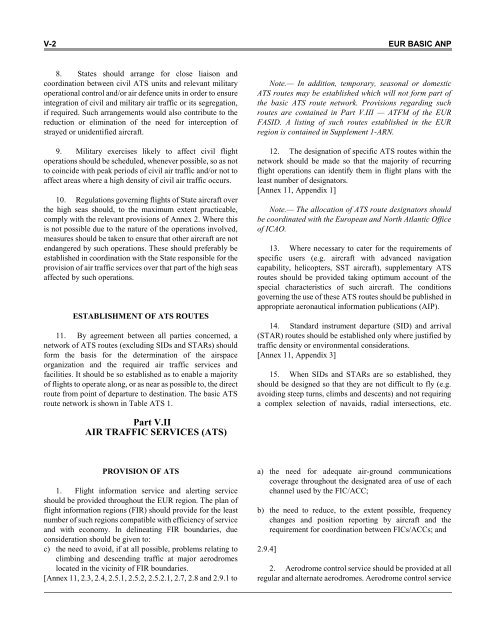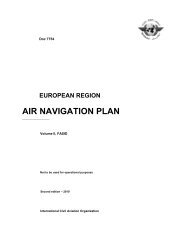7754 Vol 1 Flyleaf - ICAO Public Maps
7754 Vol 1 Flyleaf - ICAO Public Maps
7754 Vol 1 Flyleaf - ICAO Public Maps
Create successful ePaper yourself
Turn your PDF publications into a flip-book with our unique Google optimized e-Paper software.
V-2 EUR BASIC ANP<br />
8. States should arrange for close liaison and<br />
coordination between civil ATS units and relevant military<br />
operational control and/or air defence units in order to ensure<br />
integration of civil and military air traffic or its segregation,<br />
if required. Such arrangements would also contribute to the<br />
reduction or elimination of the need for interception of<br />
strayed or unidentified aircraft.<br />
9. Military exercises likely to affect civil flight<br />
operations should be scheduled, whenever possible, so as not<br />
to coincide with peak periods of civil air traffic and/or not to<br />
affect areas where a high density of civil air traffic occurs.<br />
10. Regulations governing flights of State aircraft over<br />
the high seas should, to the maximum extent practicable,<br />
comply with the relevant provisions of Annex 2. Where this<br />
is not possible due to the nature of the operations involved,<br />
measures should be taken to ensure that other aircraft are not<br />
endangered by such operations. These should preferably be<br />
established in coordination with the State responsible for the<br />
provision of air traffic services over that part of the high seas<br />
affected by such operations.<br />
ESTABLISHMENT OF ATS ROUTES<br />
11. By agreement between all parties concerned, a<br />
network of ATS routes (excluding SIDs and STARs) should<br />
form the basis for the determination of the airspace<br />
organization and the required air traffic services and<br />
facilities. It should be so established as to enable a majority<br />
of flights to operate along, or as near as possible to, the direct<br />
route from point of departure to destination. The basic ATS<br />
route network is shown in Table ATS 1.<br />
Part V.II<br />
AIR TRAFFIC SERVICES (ATS)<br />
PROVISION OF ATS<br />
1. Flight information service and alerting service<br />
should be provided throughout the EUR region. The plan of<br />
flight information regions (FIR) should provide for the least<br />
number of such regions compatible with efficiency of service<br />
and with economy. In delineating FIR boundaries, due<br />
consideration should be given to:<br />
c) the need to avoid, if at all possible, problems relating to<br />
climbing and descending traffic at major aerodromes<br />
located in the vicinity of FIR boundaries.<br />
[Annex 11, 2.3, 2.4, 2.5.1, 2.5.2, 2.5.2.1, 2.7, 2.8 and 2.9.1 to<br />
Note.— In addition, temporary, seasonal or domestic<br />
ATS routes may be established which will not form part of<br />
the basic ATS route network. Provisions regarding such<br />
routes are contained in Part V.III — ATFM of the EUR<br />
FASID. A listing of such routes established in the EUR<br />
region is contained in Supplement 1-ARN.<br />
12. The designation of specific ATS routes within the<br />
network should be made so that the majority of recurring<br />
flight operations can identify them in flight plans with the<br />
least number of designators.<br />
[Annex 11, Appendix 1]<br />
Note.— The allocation of ATS route designators should<br />
be coordinated with the European and North Atlantic Office<br />
of <strong>ICAO</strong>.<br />
13. Where necessary to cater for the requirements of<br />
specific users (e.g. aircraft with advanced navigation<br />
capability, helicopters, SST aircraft), supplementary ATS<br />
routes should be provided taking optimum account of the<br />
special characteristics of such aircraft. The conditions<br />
governing the use of these ATS routes should be published in<br />
appropriate aeronautical information publications (AIP).<br />
14. Standard instrument departure (SID) and arrival<br />
(STAR) routes should be established only where justified by<br />
traffic density or environmental considerations.<br />
[Annex 11, Appendix 3]<br />
15. When SIDs and STARs are so established, they<br />
should be designed so that they are not difficult to fly (e.g.<br />
avoiding steep turns, climbs and descents) and not requiring<br />
a complex selection of navaids, radial intersections, etc.<br />
a) the need for adequate air-ground communications<br />
coverage throughout the designated area of use of each<br />
channel used by the FIC/ACC;<br />
b) the need to reduce, to the extent possible, frequency<br />
changes and position reporting by aircraft and the<br />
requirement for coordination between FICs/ACCs; and<br />
2.9.4]<br />
2. Aerodrome control service should be provided at all<br />
regular and alternate aerodromes. Aerodrome control service














